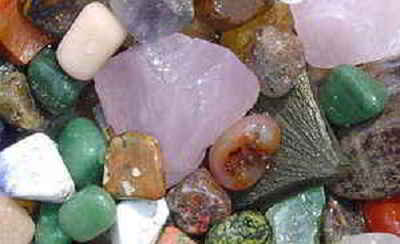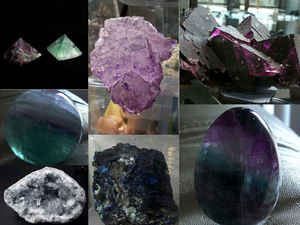Wisconsin State Mineral
Galena (Lead sulfide)

(Lead Sulphide)
Adopted on March 9, 1971.
The state mineral became Galena at the same time red granite became the state rock, thanks to the proposal put fourth by the Kenosha Gem and Mineral Society in 1971. They wanted to promote awareness of Wisconsin's geology. Galena was selected because of its abundance, uniqueness, economic value, historical significance, and because it is native to our state. Galena is the most important mineral source of lead. It grows in cubes or square crystals and is dark gray.
Chapter 14, Laws of 1971, amended Section 1.10 to make galena the official state mineral and red granite the state rock. Galena was declared the official state Mineral in 1971.
Wisconsin State Mineral: Galena

The Kenosha Gem and Mineral Society proposed the bill for the state mineral and rock. The Wisconsin Geological Society set down the criteria for picking the state mineral. The criteria included: historical significance, native nature, uniqueness, abundance and economic value. Red granite is an igneous rock composed of quartz and feldspar. It is mined in several sections of the state and was selected as the state rock because of its economic importance.
Galena is the primary ore mineral of Lead. Worked for its lead content as early as 3000BC, it is found in ore veins with Sphalerite, Pyrite and/or Chalcopyrite, and in Sedimentary rocks as beds or impregmentations. The crystals are bright when fresh but often receive a dull tarnish after exposure to air.
Galena is a common and popular mineral for rock hounds. Its characteristic cubes, distinctive cleavage and high density make it easy to identify and a favorite in high school geology labs. The structure of Galena is identical to that of halite, NaCl. The two minerals have the same crystal shapes, symmetry and cleavage. Some Galena may contain up to 1% silver in place of lead. The large volume of Galena that is processed for lead produces enough Silver as a by product to make Galena the leading ore of Silver.
PHYSICAL CHARACTERISTICS of Galena:

Galena, also called lead glance, is the natural
mineral form of lead(II) sulfide. It is the most important ore of lead and an important source of silver.
Galena is one of the most abundant and widely distributed sulfide minerals. It crystallizes in the cubic crystal system often showing octahedral forms.
It is often associated with the minerals sphalerite, calcite and fluorite.
- Color is lead to silver gray sometimes with a bluish tint.
- Luster is metallic to dull in weathered faces.
- Transparency crystals are opaque.
- Crystal System is isometric; 4/m bar 3 2/m
- Crystal Habits include the cube, octahedron and combinations of the two. Spinel twinning is possible forming flattened crystals. Also massive and granular.
- Cleavage is perfect in four direction forming cubes.
- Fracture is uneven and rarely seen because of the perfect cleavage.
- Hardness is 2.5+
- Specific Gravity is approximately 7.5+ (heavy even for metallic minerals)
- Streak is lead gray
- Associated Minerals are calcite, dolomite, sphalerite, pyrite and other sulfide minerals, also lead oxidation minerals such as cerussite and anglesite.
- Other Characteristics: brighter metallic luster on cleavage surfaces than on crystal faces.
- Notable Occurances include Texas-Oklahoma-Missouri area, USA; Germany, Peru, Mexico, Zambia, and England.
- Best Field Indicators are crystal habit, cleavage and, perhaps most importantly, density.
Wisconsin Law
The law designating Galena (lead sulfide) as the official Wisconsin state mineral is found in the Wisconsin Statutes, Chapter 1, Section 1.10(3)(n)
CHAPTER 1. SOVEREIGNTY AND JURISDICTION OF THE STATE.
1.10. State song, state ballad, state waltz, state dance, and state symbols.
1.10(3) The Wisconsin state symbols are as follows:
1.10(3)(a)
(a) The mourning dove (zenaidura macroura corolinensis linnaus) is the symbol of peace.
1.10(3)(b)
(b) Milk is the state beverage.
1.10(3)(c)
(c) The sugar maple (acer saccharum) is the state tree.
1.10(3)(d)
(d) Corn (Zea mays) is the state grain.
1.10(3)(e)
(e) The wood violet (viola papilionacea) is the state flower.
1.10(3)(f)
(f) The robin (turdus migratorius) is the state bird.
1.10(3)(g)
(g) The muskellunge (Esox masquinongy masquinongy Mitchell) is the state fish.
1.10(3)(h)
(h) The badger (taxidea taxus) is the state animal.
1.10(3)(i)
(i) The dairy cow (bos taurus) is the state domestic animal.
1.10(3)(j)
(j) The white-tailed deer (odocoileus virginianus) is the state wildlife animal.
1.10(3)(k)
(k) The American water spaniel is the state dog.
1.10(3)(L)
(L) The honey bee (apis mellifera) is the state insect.
1.10(3)(m)
(m) The trilobite (calymene celebra) is the state fossil.
1.10(3)(n)
(n) Galena (lead sulfide) is the state mineral.
1.10(3)(o)
(o) Red granite is the state rock
1.10(3)(p)
(p) Antigo silt loam (typic glossoboralf) is the state soil.
1.10(3)(r)
(r) The cranberry (vaccinium macrocarpon) is the state fruit.
Minerals, & Gems

Gemstone, Minerals, Rocks







